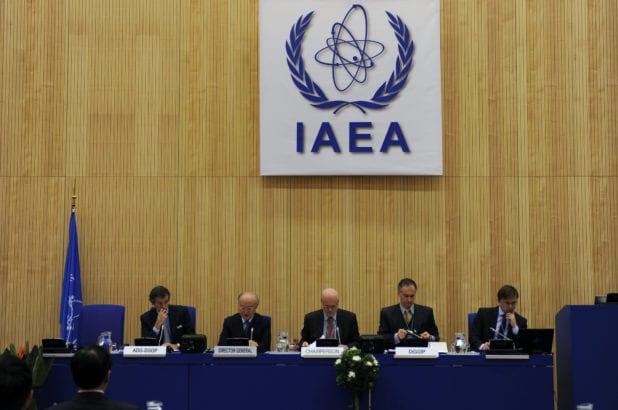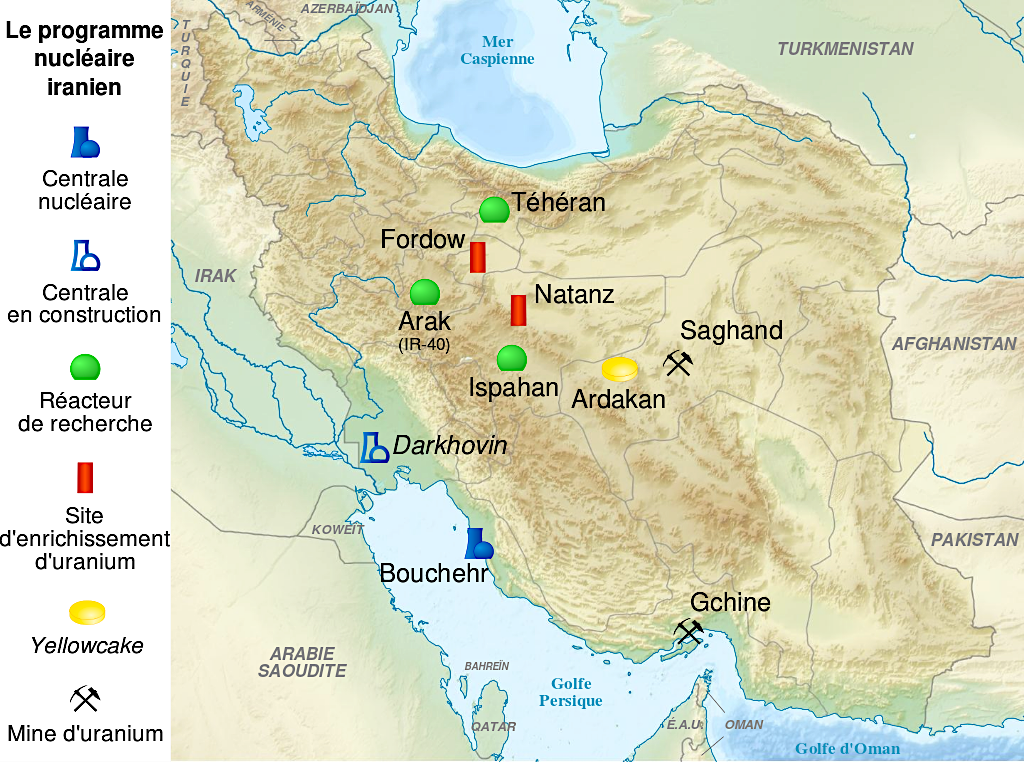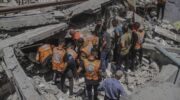IAEA meeting on proposed Nuclear-Weapon-Free Zone in the Middle East. Vienna, Austria, 21-22 November 2011. (Dean Calma / IAEA)
An IAEA resolution based on questionable Israeli intelligence has sparked a crisis with Iran that could spin out of control, warns Scott Ritter.
By Scott Ritter, reposted from Consortium News
The Iran nuclear deal that the Trump administration pulled out of last year is on the verge of collapse.
The National Security and Foreign Policy Committee of the Iranian Parliament last Tuesday ratified a motion that required the Iranian government to cease its voluntary implementation of its Additional Protocol agreement with the International Atomic Energy Agency (IAEA).
The motion, if turned into law, would represent a death knell to the 2015 Joint Comprehensive Program of Action (JCPOA), the groundbreaking agreement between Iran and the United States, Great Britain, France, Russia, China, Germany, and the European Union to end the crisis surrounding Iran’s nuclear program.
There is still time before the matter could be brought up for a vote; indeed, the committee is scheduled to hold a hearing on July 6, and has invited Foreign Minister Mohammad-Javad Zarif and Nuclear Chief Ali-Akbar Salehi to testify.
IAEA Resolution
The current crisis over Iran’s nuclear program was triggered by the IAEA Board of Governors, which on June 19 passed a resolution expressing its “serious concern” over Iran’s refusal to provide “access to the Agency under the Additional Protocol to two locations.” The resolution said that “discussions engaged, for almost a year, to clarify Agency questions related to possible undeclared nuclear material and nuclear related activities in Iran have not led to progress.”
The Board of Governors resolution required that “Iran shall cooperate fully and in a timely manner” with the IAEA in implementing its Comprehensive Safeguards Agreement and Additional Protocol, including “by providing acces.” The resolution reaffirmed that such “cooperation and implementation are essential for the IAEA to reach the Broader Conclusion that all nuclear material in Iran remains in peaceful activities.”
The First Three Years of the Deal
IAEA meeting on proposed Nuclear-Weapon-Free Zone in the Middle East. Vienna, Austria, 21-22 November 2011. (Dean Calma / IAEA)
The Board of Governor’s June 19 resolution did not occur in a vacuum. For the first three years of the JCPOA’s implementation, Iran was repeatedly certified as being in full compliance with all of its obligations, including granting IAEA inspector’s access to facilities and locations mandated by the additional protocol.
The protocol is an expanded set of requirements for information and access between Iran and the IAEA. It assists IAEA inspectors to confirm that states are using nuclear material for solely peaceful purposes. The protocol is a voluntary agreement and is independently constructed between a state and the IAEA.
Iran negotiated its additional protocol with the IAEA in 2003, which was signed but never ratified. Nevertheless, Iran implemented the protocol on a voluntary basis from 2003 to 2006 before ending its cooperation in the face of allegations that Iran was cheating.
Iran and the IAEA then entered a decade-long confrontation, which was only resolved with the implementation of the JCPOA nuclear deal, which was unanimously endorsed by the UN Security Council in resolution 2231 on July 20, 2015. That made the JCPOA binding under both international and U.S. constitutional law.
The nuclear deal established a road map, framed by mutually binding commitments, that took Iran from zero tolerance over nuclear enrichment, to a time when Iran would be able to enrich uranium for peaceful purposes without restriction, as long as the IAEA confirmed that Iran’s entire nuclear program had no military intentions. According to the deal, Iran would be subjected to stringent safeguards inspections that included the additional protocol.
Iran Reacts to Trump’s Move
When the Trump administration, acting on President Trump’s [or, perhaps more likely, Sheldon and Miriam Adelson’s] belief that the JCPOA was a “bad agreement,” withdrew from the JCPOA and began re-imposing U.S. economic sanctions, which had been lifted under the terms of the deal, Iran indicated that it would reconsider its participation.
For the time being, Iran continued to abide by its obligations under the deal, accepting European Union and the other JCPOA nations’ guarantees that regardless of what the U.S. did vis-à-vis sanctions, the other nations would not follow suit, and thereby fulfill their commitments to Iran under the terms of the JCPOA.
A year after the U.S. withdrawal from the deal, however, Europe collectively reneged on that commitment, succumbing to the threat of U.S. secondary sanctions, which threatened any European business that engaged in commerce with Iran.
In response, Iran invoked Articles 26 and 36 of the JCPOA. Article 26 holds that if new nuclear-related sanctions are imposed on Iran by any party to the deal it will constitute “grounds (for its authorities) to cease performing its commitments under this JCPOA in whole or in part.”
Article 36 states that if actions by parties to the JCPOA “constitute significant non-performance, then (Iran) could treat the unresolved issue as grounds to cease performing its commitments under this JCPOA in whole or in part and/or notify the UN Security Council that it believes the issue constitutes significant non-performance.”
Iran stressed at the time that its retaliatory measures would be reversible as soon as Europe ignored the threat of secondary U.S. sanctions and fulfilled its obligations regarding sanctions-free trade with Iran.
Initially, Iran increased its enriched uranium stockpile to beyond the 300 kilograms limit set by the JCPOA. When the Europeans continued to balk, Iran began enriching uranium to purity rates beyond the JCPOA limit of 3.76 percent.
Next, when Europe failed to meet a 60-day deadline to fulfill its commitments, Iran began to operate advanced centrifuges capable of boosting its enriched uranium stockpile, as well as activating advanced centrifuges for research and development purposes.
Lastly, in November 2019, Iran began injecting uranium gas into centrifuges at its Fordow plant, something which, while prohibited under the JCPOA, was conducted under IAEA inspection.
Interestingly, the IAEA Board of Governor’s June 19 resolution did not address these actions in any depth. Instead, the focus of attention was on the issue of Iran’s implementation of the additional protocol.
As noted, Iran had entered into voluntary compliance with the IAEA of an additional protocol agreed in 2003, but withdrew in 2006 in the face of allegations derived from intelligence provided to the IAEA by Israel of Iranian cheating [see: article published today in Consortium News, “Israel Leverages Dubious ‘Nuclear Archives’ to Re-Enlist IAEA in Campaign Against Iran.“]
Under the JCPOA, Iran agreed to implement its additional protocol on a “provisional” basis for up to eight years before it became legally binding.
Iran insisted on these terms in order to prevent the kind of scenario that is, in fact, playing out today, where the United States has re-imposed sweeping economic sanctions against Iran, and is seeking to trigger so-called “snap-back” sanctions that would return Iran to the regimen of measures previously imposed by the Security Council, but terminated upon the council’s endorsement of the nuclear deal.
Israeli Allegations
The Board of Governor’s resolution mentions two sites that are alleged to be engaged in ongoing, undeclared nuclear activity. Normally, these sites would be ideal candidates for the kind of inspections envisioned under the protocol, and indeed Iran has a history of providing similar access to other sites.
What separates these sites from the others is that Iran claims the allegations about them are a product of Israeli intelligence, and as such are deemed to be fabrications designed to provoke Iran. “No country,” Kazem Gharibabadi, Iran’s ambassador told the Board of Governors before its vote on the June 19 resolution, “opens its territory to the inspections only based on continuous allegations provided by its own enemy, even if it is evident that the result of which will prove those allegations to be false.”
Iran’s position on the two sites does not appear to be out of fear over what would be discovered—indeed Iranian President Hassan Rouhani told the United Nations in September 2019 that, “If the U.S. Congress ratifies the JCPOA and lifts all sanctions permanently, Iran is ready to pursue the immediate ratification of the Additional Protocol in the Iranian parliament as a permanent law.”
‘Nothing to Hide’
Rather, it is a matter of principle for Iran. Indeed, Foreign Minister Zarif noted in a tweet that “an agreeable solution is possible” for the IAEA’s request for access to the two nuclear sites in the country—but not if Iran was subjected to pressure in the form of a Board of Governor’s resolution predicated on Israeli intelligence.
“We’ve nothing to hide,” Zarif tweeted. “More inspections in Iran over last 5 yrs than in IAEA history. An agreeable solution is possible, but Res will ruin it.”
Zarif’s warning was of no avail. Shortly after the Board of Governors passed its resolution, U.S. Secretary of State Mike Pompeo issued a statement declaring that:
“Iran’s denial of access to IAEA inspectors and refusal to cooperate with the IAEA’s investigation is deeply troubling and raises serious questions about what Iran is trying to hide. Over the past months, Iran has not only continued its nuclear escalation and extortion, but it has also stonewalled the IAEA. These actions are unacceptable and underscore the continued threat posed by Iran’s nuclear program to international peace and security.”
The battle lines have been drawn. By caving into pressure from the United States to force a resolution by the Board of Governors, the European nations who are party to the JCPOA have done great harm to that agreement.
Having forced a showdown with Iran over the issue of access to sites based upon intelligence of questionable provenance, the IAEA has once again opted to take the world to the brink of a crisis with Iran which could ultimately see that nation withdraw not only from the JCPOA, but also the Non-Proliferation Treaty (NPT).
Not only would such an outcome undermine the issue of global nuclear nonproliferation, but also more than likely put Iran on a path toward the kind of decisive military confrontation that would spell ruin for the Middle East and, by extension, the entire world.
Scott Ritter is a former Marine Corps intelligence officer who served in the former Soviet Union implementing arms control treaties, in the Persian Gulf during Operation Desert Storm, and in Iraq overseeing the disarmament of WMD.
RELATED:
Israel Leverages Dubious ‘Nuclear Archives’ to Re-Enlist IAEA in Campaign Against Iran
Trump Has A $259 Million Reason To Bomb Iran
Timeline of US-Iran conflict: 1953 through Present
The effort on behalf of Israel to destroy Iran’s ability to defend itself
Intelligence Experts to Trump: Intel on Iran Could be CATASTROPHIC
Pro-Israel Treasury Secretary Steve Mnuchin censors Iranian news website








